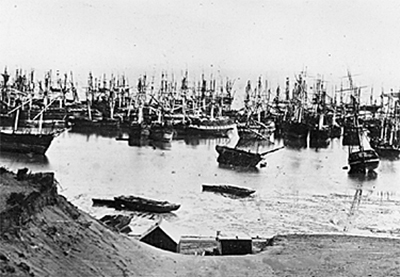
Abandoned Ships
"Abandoned Ships" off Rincon Point, as seen from Happy Valley, from a
panorama of San Francisco, 1851. (Courtesy San Francisco Maritime National Historical Park, J.
Porter Shaw Library. A11.16541n).
"Our harbor is now literally crowded with ships," exclaimed an editorial from a San Francisco newspaper in August of 1850. Vessels were obstructing everyday steamer traffic -- many remained stationary for months at a time. Finally, a number of storeships and other idled vessels were shifted south of Market Street, away from the active business core, to lie off the waterfront's industrial area at Rincon Point. A daguerreotype panorama of the city taken in late 1852 or early 1853 shows a number of vessels lying at haphazard abandonment, including the hulk with the legend "storage" painted on its bulwarks next to another vessel with a housed-over "barn" on its deck.
Those ships that could not be shifted because they were blocked in by landfill or construction were broken up where they lay. The presence of literally hundreds of near-derelict vessels of San Francisco provided an ideal business opportunity to an entrepreneur seeking to make a living from recycling materials from the ships. The majority of this work, which occurred from 1851 to 1852, took place at Rincon Point. While shipbreaking was a labor-intensive and unpleasant job with a low margin of return, the proximity of a nearby, cheap labor force provided the means to an end. That labor force was a group of approximately 150 Chinese who lived in a fishing village at the southern end of Rincon Point.
Previous Next
